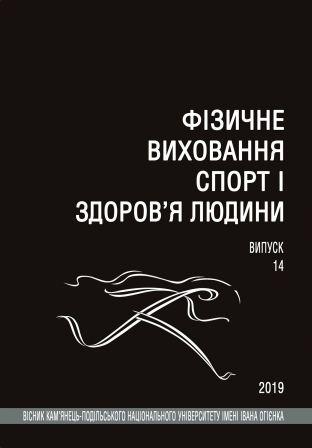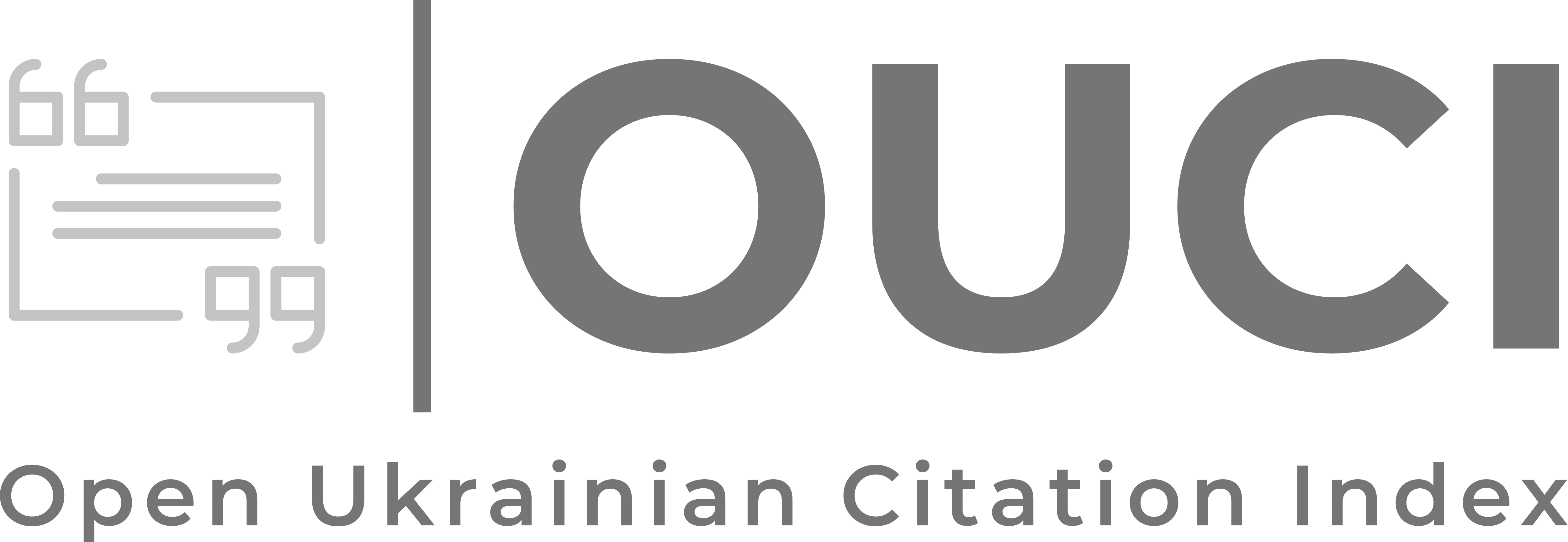IMPLEMENTATION OF INNOVATIVE PEDAGOGICAL TECHNOLOGIES I N THE CONTROL OF PHYSICAL EDUCATION OF STUDENTS OF SPECIAL MEDICAL GROUPS
DOI:
https://doi.org/10.32626/2309-8082.2019-14.5-9Ключові слова:
physical education, student, special medical group, innovation, technology, efficiencyАнотація
The relevance of the study is due to the objective need to increase the effectiveness of physical education of students in special medical groups during their training in higher education institutions. A promising direction for solving this problem is the development and practical implementation of new, highly effective control technologies. The purpose of the research: to identify conceptual approaches, the main tasks and mechanisms of the implementation of innovative pedagogical technology for controlling the physical education of students of special medical groups. Material and methods. The basis of the research is the use of a complex of general scientific theoretical methods: analysis, systematization, generalization, theoretical modeling. Results. The basic preconditions and bases of development and introduction of innovative technologies for control of physical education as the process of modernization of the existing control system are analyzed. Formulated conceptual approaches in this process, taking into account the specifics of the contingent of special medical groups. The task is substantiated, the structural components of the mechanism of implementation of innovative control technology are presented and analyzed. In the development of innovative technology, all cycles of diagnostics and management are integrated – from gathering information about the current state of the organism of students to the formation of managerial decisions. The theory of the regulation of cybernetic systems, the main elements of which are programming, screening, correction, is based on the innovative technology of controlling the course of physical education of students. The criterion for the effectiveness of the proposed provisions is the final analysis of the dynamics of the parameters of the psychophysical state of students of special medical groups in the process of their physical education. Conclusions. Integration of innovative technologies, through qualitative changes in the control of physical education of students of special medical groups, leads to an increase in the effectiveness of this process, before quantitative and qualitatively new results. The structure of technology presented in the work allows developing integrated algorithms of activity of subjects of realization of innovations, in order to ensure effective implementation of control of physical education of students of special medical groups, and, thus, increase of efficiency of this process in general.
Посилання
Ayers SF. (2004). High School Students’ Physical Education Conceptual Knowledge. Research Quarterly for Exercise and Sport, 75(3): 272–287. DOI: 10.1080/02701367.2004. 10609160.
Baghurst T., & Mwavita M. (2014). Evaluation, rationale, and perceptions regarding fitness testing in physical education teacher education programs. The Global Journal of Health and Physical Education Pedagogy, 3: 348-364.
Bassett DR. ( 2000). Validity and reliability issues in objective monitoring of physical activity. Research Quarterly for Exercise and Sport, 71: 30–36.
Вlavt О. (2016). System of control in physical education of students of special medical groups. Lviv Polytechnic Publishing House.
Di Tore P.A., Schiavo R., & D’isanto T. (2016). Physical education, motor control and motor learning: theoretical paradigms and teaching practices from kindergarten to high school. Journal of Physical Education and Sport, 16(4): 1293–1297. DOI:10.7752/jpes.2016.04205.
Grabowski H. (2000). Co koniecznie trzeba wiedzieć o wychowaniu fizycznym. Kraków : Oficyna Wydawnicza «Impuls».
Gurtova TV., Korol OS., Nesgoda SP., & Stetsiak OB. (2019). Physical culture as an object of innovations in higher education institutions: a modern approach. Scientific Journal of the National Pedagogical University named after. MP Drahomanov. Series 15: Scientific and pedagogical problems of physical culture (physical culture and sports), 2(108): 33–36.
Humphrey N., Lendrum A., Barlow A., Wigelsworth M., & Squires G. (2013). Achievement for All: Improving psychosocial outcomes for students with special educational needs and disabilities. Research in Developmental Disabilities, 34(4): 1210–1225. DOI:10.1016/j.ridd.2012.12.008.
Iedynak G., Galamandjuk L., Kyselytsia O., Balatska L., Nakonechnyi I., Mazur V. (2017). Physiological characteristics of pubertal schoolchildren with chronic diseases. Journal of Physical Education and Sport. 17(4): 2462–2466. doi:10.7752/jpes.2017.04275
Keating XD., & Silverman S. (2009). Determinants of teacher implementation of youth fitness tests in school-basedphysical education programs. Physical Education & Sport Pedagogy, 14(2): 209–225. DOI:10.1080/17408980801974945.
Кoryahin V., Вlavt О., Bakhmat N., Guska М., Ludovyk Т., Prozar М., Bodnar А., Кravets S., & Bezgrebelnaya Е. (2019). Differentiated correction of attention abilities of students with chronic diseases during physical education. Journal of Physical Education and Sport, 19(2): 293–298. DOI:10.7752/jpes.2019.s2044.
Lyosota TI. & Levytska ОМ. (2017). Innovative technologies in the system of physical education of students. Young Scientist, 3.1(43.1): 202–205.
Metzler М. (2011). Instructional Models in Physical Education. 3 edition. Routledge.
Macleod G., & Cebula KR. (2009). Experiences of disabled students in initial teacher education. Cambridge Journal of Education, 39(4): 457–472. DOI:10.1080/03057640903352465.
Overton H., Wrench А., & Garrett R. (2016). Pedagogies for inclusion of junior primary students with disabilities in physical education. Physical Education and Sport Pedagogy, 22(4), 414–426. DOI:10.1080/17408989.2016.1176134.
Physical education of students / Ed. VM. Кoryahin (2018). Lviv Polytechnic Publishing House.
Schislovsky SV. (2015). Some indicators of physical state of the high school students on the stage of implementation of contents of the physical culture program. Journal of Education, Health and Sport, 5(7): 631–640.
Shiyan, B. M, Iedynak, G. A., Petryshyn, Y. V. (2012), Naukovi doslidzhennya u fizychnomu vykhovanni ta sporti [Scientific research in physical education and sports], Oiyum, Kamyanets-Podilsky, Ukraine.
Silverman S., Keating XD., & Phillips SR. (2008). A lasting impression: A pedagogical perspective on youth fitness testing. Measurement in Physical Education and Exercise Science, 12: 146-166. DOI: 10.1080/10913670802216122.
Stolyarov VI. (2015). Theory and methodology of modern physical education: state of development and author’s concept: monograph. K.: Olympic literature.
Tymoshenko OV., & Demin ZhG. (2016). How to modernize the national system of physical education? Modern Educational Dimension. Education, 15: 6–10.
##submission.downloads##
Опубліковано
Як цитувати
Номер
Розділ
Ліцензія
Авторське право (c) 2021 Вісник Кам’янець-Подільського національного університету імені Івана Огієнка. Фізичне виховання, спорт і здоров’я людини

Ця робота ліцензується відповідно до Creative Commons Attribution-NonCommercial 4.0 International License.




